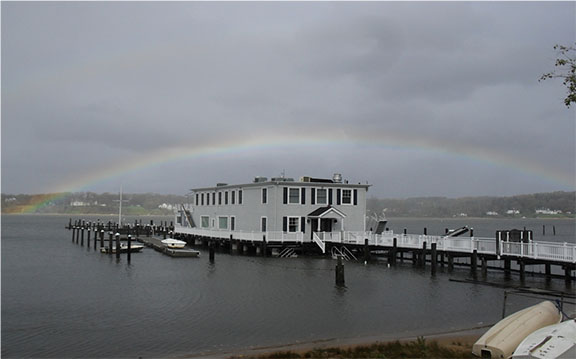
Photo courtesy SRYC
By Randall Gabrielan
FAIR HAVEN – On June 17, the Shrewsbury River Yacht Club was entered into the National Register of Historic Places, having earned the designation by architectural distinction. While the Colonial Revival-style building, the organization’s third clubhouse, was dedicated July 3, 1929, its style and look gave a nod to the club’s initial headquarters that dated from its founding in 1910.
The new building, designed by architect Ernest A. Arend who lived in Red Bank and practiced in Asbury Park, was planned to embody the spirit and image of the houseboat utilized by the club founders, a group of vaudeville actors, as their first headquarters. While architecture qualified the listing, the history of a group originally called the Players Boat Club, contributed significance.
Arend, who began his practice around 1896 in his native Trenton in partnership with Samuel Brouse, retained the firm’s Asbury Park office as a sole practitioner when the firm dissolved in 1902. His diverse practice included many residences, educational and institutional buildings. Arend designed in numerous styles current during the early decades of the century, including Italian Renaissance Revival, the style he employed for his Broad Street residence; Tudor Revival, and Collegiate Gothic for the former Long Branch High School; and especially Colonial Revival.
He utilized the latter for the 30-by-70-foot structure built on a 40-by-85-foot deck set on wood pilings, clad in wood shingles and located on the Navesink River at 925 River Road near the eastern edge of Fair Haven.
The Players’ first houseboat, dedicated July 4, 1910 was replaced by a larger one five years later as the club grew and prospered. Membership, limited to actors and others from the performing arts fields, consisted primarily of vaudevillians. Vaudeville, a low-brow entertainment form, was near the pinnacle of a half-century’s popularity that ran roughly from 1880-1930. Acts, often zany and at times bizarre, required frequent changes and travel to numerous venues, which created an exhausting schedule. Performers found Fair Haven a suitable locale for summer respites and the club a home for compatible personalities.
The Players Boat Club unexpectedly found itself at a crossroads when a storm in September 1928 destroyed its home. As vaudeville faded, its prospective membership base diminished. A permanent clubhouse structure would be durable, but high cost challenged the club into a two-step remedy. Nonperformers were admitted as lay members in 1929 in order to broaden financial support. Lay membership was initially a second class status that lacked voting privileges, but enabled the membership to organize a real estate firm that would plan, fund and complete new construction.
The remaining actors who controlled the club in 1929 enabled history to become an additional factor in Register designation; many were not then the oddball performers of the 1910 era. Film was killing vaudeville. In Red Bank, the Carlton Theater, now the Count Basie, opened in 1926. The next year “The Jazz Singer,” the first “talkie” motion picture was released while the Carlton installed a sound projection system in 1928.
Club members who were able sought other performing careers. One, Charles Grapewin, attained late career fame as a Hollywood character actor, appearing in films such as “Johnny Apollo” and “The Grapes of Wrath.” Another, Frederick V. Bowers, later attained major success as a composer and singer, especially of old standards including his well-known “Because” and “Always.” Bowers, a skilled pianist and speaker, moved to Hollywood and became a goodwill ambassador for the music industry.
George Watts, whose career began early in the 20th century, teamed with Jack Ryan in a talking-singing act, then joined with a number of other singers prior to enjoying a stage and film career. In 1929, The Red Bank Register reported Frank Herbert, who was “the senior member of Herbert and Carron, one of the best-known acrobatic teams in vaudeville” performed widely in Europe. Around the time the new clubhouse opened, Herbert and his wife, “well-known in the vaudeville circuits of the east” were then engaged in “a professional tour of several weeks through the New England states.”
Other old-timers who remained active included club organizer Ernie Otto, who traveled throughout the United States with musical and monologue acts. Ernie Van and his brother formed a comedy-musical team that toured the United States and Europe for over 25 years.
Tony Hunting, the key founder of the club, remained for a personally unhappy transition of the club, but one that enabled it to survive and prosper. In 1936, the lay members were given full-fledged status prior to the club’s reorganization in 1938 when they voted to change its name the next year to the Shrewsbury River Yacht Club. The club, which adopted maritime traditions and became prominent in the boating world, celebrated its centennial in 2010 with the publication of “100 Years on the Navesink – The Shrewsbury River Yacht Club: A History.”














